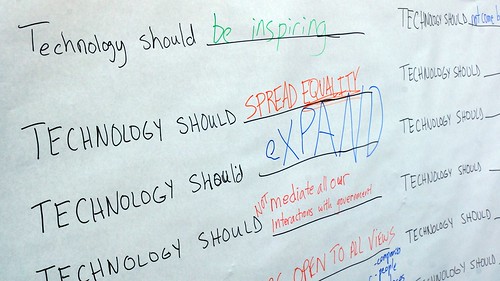
Investigate Technology
Introduction
Community technology is a principled approach to technology that is grounded in the struggle for a more just digital ecosystem, placing value on equity, participation, common ownership and sustainability. In these activities, participants will use social analysis to understand technologies we use.
Goal: Investigate the properties of common technologies, understand how these technologies impact the community, and identify community-based alternatives.
Materials:
- Paper
- Pens / Pencils
Estimated Time: 2 hours
Activity 1: Investigate Technologies
Estimated Time: 1 hour.
In a group, brainstorm a list of a few technologies you and your community use, for example:
- Your home or mobile phone network
- Online news platforms
- Social media platform
- Your computer or any software you use every day (web browser, office program)
- Your television or radio, and the programming on that service
- Your Internet Service Provider
- The local Internet cafe
Divide into groups of 3-5, and select one of the technologies you have brainstormed. Together, answer the following questions about that technology. One person in the group can write down the answers.
Ownership
1. Who owns the technology?
2. Who makes decisions about it?
3. How are decisions made?
Access
1. Who can use the technology?
2. Who is left out?
Goal or Mission
1. What is the goal or mission of the technology?
Design
1. Who designs the technology or system?
2. Who is it designed for?
Community Impact
1. Who is strengthened?
2. Are local relationships strengthened or weakened?
3. Is anyone negatively impacted?
Profit and Sustainability
1. Who profits from the technology? Are the profits or results shared? Where does the money go?
2. Does that technology generate jobs in your community?
Local Impact
1. Is the content made by people in your community?
2. Is the content for people in your community?
3. How is the local media ecosystem strengthened or weakened?
Teaching and Learning
1. How are skills and knowledge shared about the technology?
2. Who installs it? Who repairs it?
Activity 2: Reflection
Estimated Time: 20 minutes.
After the group has answered the questions, discuss the following:
- How do these characteristics impact the community?
- How would you describe the relationship between the technology and the community?
- Can you imagine a community-based alternative to this technology? If so, what would it look like?
Were there any questions missing? What questions would you add to the list?
Optional: Imagine the technology was built for and by your community. How would it be different? Write down 3-5 ways you imagine it would be different.
Select a presenter to share these ideas with the group.
Each small group should spend 1-2 minutes presenting their findings to the larger group. Discuss and write down the common themes.
Activity 3: Synthesize Ideas About Community Technology
Estimated Time: 40 minutes.
Divide into new small groups. Tip: do not use the same small groups as you did earlier.
Based on the previous discussions, define community technology. You can write a sentence, draw a diagram, or act it out, etc. What are the properties of community technology? Each group should pick one person to report back to the larger group.
Each small group should spend 1-2 minutes presenting their findings to the larger group.
As a group, discuss the common ideas. What were the common themes? What are the differences? Is there a unified vision of community technology?
Other Resources and Examples
In this section are example community technology projects. Some community technology projects create temporary, inclusive spaces for communities to design, define and explore new technologies. Below are three examples with some basic guides for creating these in your community.
DiscoTech
DiscoTechs are events that feature interactive, multimedia workshops designed to demystify, engage and inform the community about issues of Internet use and ownership, providing the tools allowing communication to be more easily recognized as a fundamental human right.
[https://store.alliedmedia.org/DiscoTechzine]
Cryptoparty
CryptoParty is a decentralized, global initiative to introduce the most basic cryptography software and the fundamental concepts of their operation to the general public, such as the Tor anonymity network, public key encryption (PGP/GPG), and OTR (Off The Record messaging).
Feminist Tech Exchange
Through skills diffusion and capacity building, the Feminist Tech Exchange (FTX) seeks to empower women’s rights organisations, advocates and feminists sidelined in the growth of the global digital commons. The Exchange has been developed in response to the expressed needs of feminist and women’s rights movements for greater understanding of emerging ICT and applications.
[http://www.apc.org/en/node/8041/]
Other community technology projects create more permanent spaces for building, creating, collaborating, and designing technologies.
Makerspaces
Makerspaces are community centers with tools. They combine manufacturing equipment, community, and education for the purposes of enabling community members to design, prototype and create manufactured works that wouldn’t be possible to create with the resources available to individuals working alone.
Hackerspaces
Hackerspaces are community-operated workspaces where people with common interests, often in computers, machining, technology, science, digital art or electronic art; can meet, socialize and collaborate. Hackerspaces have also been compared to separate regional community-operated spaces with similar aims and mechanisms such as “fab labs” and commercial ‘for profit’ companies.
[http://hackerspaces.org/wiki/]
Digital Justice Coalitions
Digital Justice Coalitions are comprised of people and organizations who connect social justice issues with media, technology, economic development, digital literacy, and other issues. They are based on a variety of values including communication as a fundamental human right, media as a tool to connect communities, and foster healthy relationships. The Detroit Digital Justice Coalition and Media Literacy Project in Philadelphia are good examples.
Some community technology projects create platforms that allow communities to share information and communicate.
Community radio stations
Community radio is a third model of radio broadcasting in addition to commercial and public broadcasting. They serve geographic communities and communities of interest. They broadcast content that is popular and relevant to a local, specific audience but is often overlooked by commercial or mass-media broadcasters. They are operated, owned, and influenced by the communities they serve. AMARC and Prometheus Radio Project are good resources for community radio stations.
Community (wireless) networks
Community networks are an alternative to commercial or municipal wireless networks for consumers. Usually residents put wireless routers on their rooftops or windows to link neighbor to neighbor. There are also many networks worldwide, including Guifi, Detroit Digital Stewards’ Community Networks, Red Hook WiFi, Athens, Altermundi, Freifunk, etc. In addition, there are many software and hardware projects to support community wireless networks (MeshPotato, Freifunk, Guifi, Commotion). The Commotion Construction Kit is a guide to community wireless.
Community mobile phone networks
Some communities are now building their own cellular networks, usually in areas ignored by major carriers. These use new information and communication technologies, to facilitate development and community organization. They typically combine regulatory reform, decentralization, community involvement, and the application of new technologies to build cellular networks. Rhizomatica is a good example of a successful community mobile phone network.
Community wikis and blogging platforms
Community platforms to write about and share events, current affairs, news, and stories for a specific community. These can take many forms, but are often news or issue-centric websites. A “Wiki” makes community collaboration into a structure where users of the site can add, edit and delete content as they see fit.
Community storytelling using IVR or SMS
Interactive Voice Response (IVR) and text messaging (SMS or MMS) systems allow anyone with a phone to text, record, and report on events, news, opinions, or just tell their stories. The messages and recordings can be used for many purposes, but often are curated or automatically posted to a community website for others to read, listen to, and comment on. These allow for groups of people who may not have access to computers or the Internet to tell their stories. Vojo and CGNet Swara are good examples of community storytelling and reporting platforms.
